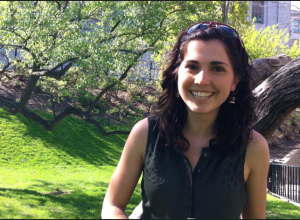WSC’s Ziter gets grant to find out what happens next
Post by Jenny Seifert
National Geographic may be a sucker for charismatic fauna and remote places, if the pages of their magazine are any indication, but they also value explorations that are less flashy and closer to home, yet equal in impact.

WSC’s Carly Ziter receives Young Explorers grant from National Geographic.
The global scientific and educational institution recently awarded one of the Water Sustainability and Climate (WSC) project’s graduate students, Carly Ziter, a Young Explorers grant to conduct place-based research on how a tiny, wriggly critter called the Asian jumping worm, an invasive species, might impact a typical Midwestern landscape, our very own Yahara Watershed.
The grant supports promising young scientists who are exploring new knowledge frontiers that could lead to a better understanding of the world, and perhaps a better world.
Ziter won’t be bushwhacking in any jungles, but her exploration could nonetheless inform efforts to sustain and improve the many natural benefits we get from our own backyard.
“It’s really exciting to me that National Geographic was interested in funding this local conservation work, which I really enjoy doing because I’m connecting with my own landscape and community,” says Ziter, a PhD student in the department of zoology at the University of Wisconsin-Madison.
Ziter will investigate how the Asian jumping worm, a nearly unstudied species scientifically known as Amynthas agrestis, could interact with another invasive species in the region, a shrub called buckthorn, and how this interaction could, in turn, impact the many benefits people get from the watershed, or ecosystem services, such as recreation, crop production and carbon storage.
Buckthorn is among the most problematic invasive plant species in the Midwest. It out-competes native plants, degrades wildlife habitat, exacerbates erosion and hosts agricultural pests, such as the soybean aphid.
It also might be really delicious to the Asian jumping worm, which is notorious for its voracious eating habits.

The Asian jumping worm is a new invasive species to Wisconsin. Photo by Jiangxiao Qiu.
“Buckthorn leaves are really high in nitrogen, and so the worms might preferentially choose to eat those,” says Ziter.
Existing research on the well-studied European earthworm—also an invasive species, but a long-established and well-acclimated one—shows they prefer leaf litter rich in nutrients, especially nitrogen, which is much tastier and easier for them to consume.
“We’re hypothesizing that this same relationship will hold for the jumping worms, but nobody has actually tested their litter preferences yet, which is part of what makes this study exciting,” explains Ziter.
At the same time, as the worm devours leaf litter from the soil surface, it could clear the way for invasive plants to take root, like buckthorn, which grows well on bare soil.
To study this potential worm-buckthorn interaction, Ziter will use her Young Explorers grant to conduct two experiments, one to see whether the worm favors buckthorn leaves more than native species like maple and oak, the other to see whether the presence of the worm allows buckthorn to grown more easily than it could otherwise.
Knowing how the worm and shrub interact can help Ziter and other scientists understand what long-term consequences these invasive species could bring for ecosystem services. In turn, this knowledge can help us plan for the future.
“It might allow us to focus more on control or on preventing the spread of these species in specific areas. Alternatively, we might realize that these species don’t actually interact in a harmful way, and we can continue to consider each individually,” says Ziter.
In addition to enabling Ziter to advance local conservation knowledge, the grant provides her access to a network of fellow early career explorers, social capital Ziter says, “can go a long way.”
Ziter will conduct her experiments this summer in the UW-Madison Arboretum, a project partner and ground zero for where the worms made their first Wisconsin appearance in 2013.
Her study will build on research by fellow WSC graduate student Jiangxiao Qiu, who has been investigating the effects of the Asian jumping worm on soils in the Yahara.
Stay tuned to learn what Ziter finds out.
Jenny Seifert is the science writer/outreach coordinator for the Water Sustainability and Climate Project at UW-Madison.